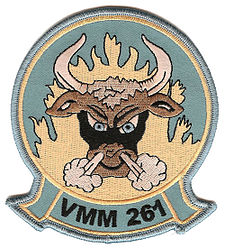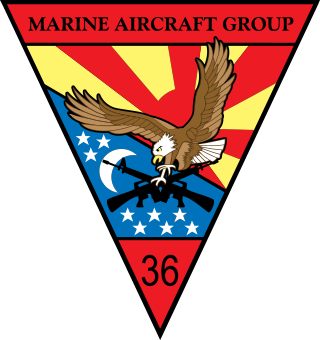
Marine Aircraft Group 36 (MAG-36) is an active air group of the United States Marine Corps, tasked with providing assault support aircraft. It is currently part of the 1st Marine Aircraft Wing, itself an integral part of the III Marine Expeditionary Force, and based at Marine Corps Air Station Futenma in Okinawa, Japan.

Marine Medium Tiltrotor Squadron 262 (VMM-262) is a United States Marine Corps tiltrotor squadron consisting of MV-22B Osprey tiltrotor aircraft. The squadron, known as the "Flying Tigers", is based at Marine Corps Air Station Futenma, Okinawa, Japan and falls under the command of Marine Aircraft Group 36 (MAG-36) and the 1st Marine Aircraft Wing.

Marine Medium Tilt Rotor Squadron 165 (VMM-165) is a United States Marine Corps Tilt-rotor squadron consisting of MV-22B Osprey transport aircraft. The squadron, known as the "White Knights", is based at Marine Corps Air Station Miramar, California and fall under the command of Marine Aircraft Group 16 (MAG-16) and the 3rd Marine Aircraft Wing.

Marine Medium Tiltrotor Squadron 161 (VMM-161) is a United States Marine Corps tiltrotor squadron that operates the MV-22 Osprey. The squadron, known as the "Greyhawks", is based at Marine Corps Air Station Miramar, California and falls under the command of Marine Aircraft Group 16 (MAG-16) and the 3rd Marine Aircraft Wing. The squadron has the distinction of being the first helicopter transport squadron in the world and regularly utilizes the phrase “The First, The Best”.

Marine Medium Tiltrotor Squadron 263 (VMM-263) is a United States Marine Corps tiltrotor squadron consisting of MV-22B Osprey transport aircraft. The squadron, known as the "Thunder Chickens", is based at Marine Corps Air Station New River, North Carolina and falls under the command of Marine Aircraft Group 26 (MAG-26) and the 2nd Marine Aircraft Wing.

Marine Aircraft Group 16 is a United States Marine Corps aviation unit based at Marine Corps Air Station Miramar that is currently composed of four V-22 Osprey squadrons, four CH-53 Super Stallion squadrons, one Personnel Support Detachment, and an aviation logistics squadron. The group falls under the command of the 3rd Marine Aircraft Wing and the I Marine Expeditionary Force.

Marine Medium Tiltrotor Squadron 268 (VMM-268) is a United States Marine Corps helicopter squadron consisting of MV-22 transport. The squadron, known as the "Red Dragons", is based at Marine Corps Base Hawaii, Kaneohe, Hawaii and falls under the command of Marine Aircraft Group 24 (MAG-24) and the 1st Marine Aircraft Wing.

Marine Medium Tiltrotor Squadron 162 (VMM-162) is a United States Marine Corps tiltrotor squadron consisting of MV-22 Osprey transport aircraft. The squadron, known as the "Golden Eagles", is based at Marine Corps Air Station New River, North Carolina and falls under the command of Marine Aircraft Group 26 (MAG-26) and the 2nd Marine Aircraft Wing. HMM-162 officially stood down December 9, 2005 to begin the process of transitioning to the MV-22 Osprey. On August 31, 2006, the squadron was reactivated as the second operational Osprey squadron in the Marine Corps.
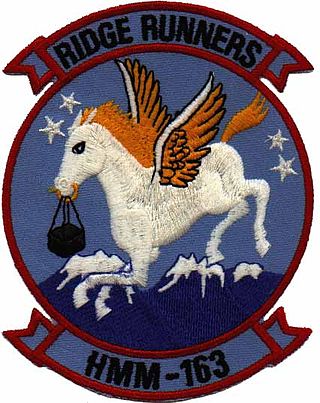
Marine Medium Tiltrotor Squadron 163 (VMM-163) is a United States Marine Corps helicopter squadron consisting of MV-22 Osprey transport tiltrotors. The squadron, known as "Evil Eyes", is based at Marine Corps Air Station Miramar, California and falls under the command of Marine Aircraft Group 16 (MAG-16) and the 3rd Marine Aircraft Wing.
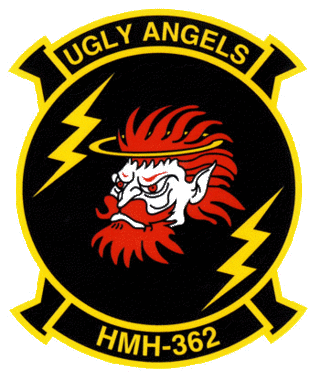
Marine Medium Tiltrotor Squadron 362 (VMM-362) is a United States Marine Corps squadron that operates MV-22 Osprey. The squadron, known as the "Ugly Angels", was reactivated on 17 August 2018 at Marine Corps Air Station Miramar, California.
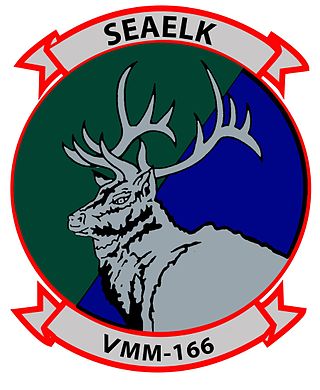
Marine Medium Tiltrotor Squadron 166 (VMM-166) was a United States Marine Corps tiltrotor squadron consisting of MV-22 Osprey transport aircraft. The squadron, known as the "SeaElk", was last based at Marine Corps Air Station Miramar, California. Activated in 1985, HMM-166 was the youngest CH-46 helicopter squadron in the Marine Corps. The squadron was redesignated as a tiltrotor squadron on June 23, 2010. The squadron was deactivated on October 1, 2021.

Marine Medium Tiltrotor Squadron 265 (VMM-265) is a United States Marine Corps transport squadron consisting of MV-22 Osprey tiltrotor aircraft. The squadron, known as the "Dragons", is based at Marine Corps Air Station Futenma, Okinawa, Japan and falls under the command of Marine Aircraft Group 36 (MAG-36) and the 1st Marine Aircraft Wing.

Marine Medium Tiltrotor Squadron 266 (VMM-266) is a United States Marine Corps tiltrotor squadron consisting of MV-22 Osprey transport aircraft. The squadron, known as the "Fighting Griffins", is based at Marine Corps Air Station New River, North Carolina falls under the command of Marine Aircraft Group 26 (MAG-26) and the 2nd Marine Aircraft Wing.

Marine Heavy Helicopter Squadron 461 (HMH-461) is a United States Marine Corps helicopter squadron consisting of CH-53K King Stallion transport helicopters. The squadron, known as "Ironhorse", is based at Marine Corps Air Station New River, North Carolina and falls under the command of Marine Aircraft Group 29 (MAG-29) and the 2nd Marine Aircraft Wing. With its lineage starting in 1944, HMH-461 is the oldest active Heavy Lift Helicopter Squadron in the Marine Corps.

Marine Medium Tiltrotor Squadron 264 (VMM-264) was a United States Marine Corps tiltrotor squadron consisting of MV-22 Osprey transport aircraft. The squadron, known as the "Black Knights", was based at Marine Corps Air Station New River, North Carolina, and normally fell under the command of Marine Aircraft Group 26 (MAG-26) and the 2nd Marine Aircraft Wing. They were the last east coast CH-46 Sea Knight squadron to transition to the Osprey. VMM-264 was decommissioned on June 24, 2020.
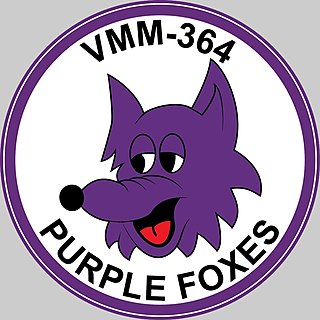
Marine Medium Tiltrotor Squadron 364 (VMM-364) is a United States Marine Corps medium-lift tiltrotor squadron consisting of MV-22B Ospreys. The squadron, known as the "Purple Foxes", is based at Marine Corps Air Station Camp Pendleton, California and falls under the command of Marine Aircraft Group 39 (MAG-39) and the 3rd Marine Aircraft Wing.

Marine Medium Tiltrotor Squadron 365 (VMM-365) is a United States Marine Corps tiltrotor squadron consisting of MV-22B Osprey transport aircraft. The squadron, known as the "Blue Knights", is based at Marine Corps Air Station New River, North Carolina and falls under the command of Marine Aircraft Group 26 (MAG-26) and the 2nd Marine Aircraft Wing.

Marine Medium Tiltrotor Squadron 764 (VMM-764) is a United States Marine Corps Reserve squadron consisting of MV-22B Ospreys. The squadron, known as "Moonlight," is based at Marine Corps Air Station Miramar in San Diego, CA and falls under the command of Marine Aircraft Group 41 (MAG-41) and the 4th Marine Aircraft Wing.

Marine Medium Tiltrotor Squadron 164 (VMM-164), is a United States Marine Corps tiltrotor squadron operating the MV-22B Osprey. Known as the Knightriders, they fall under the command Marine Aircraft Group 39 (MAG-39) and the 3rd Marine Aircraft Wing. They are based at Marine Corps Air Station Camp Pendleton.

Marine Medium Tiltrotor Squadron 363 (VMM-363) is a United States Marine Corps tiltrotor squadron consisting of MV-22B Ospreys. The squadron, known as the "Lucky Red Lions", is based at MCB Hawaii and falls under the command of Marine Aircraft Group 24 (MAG-24) and the 1st Marine Aircraft Wing.
